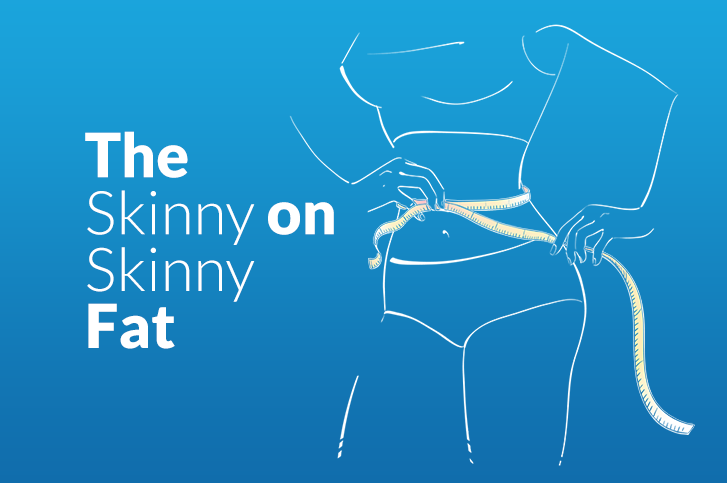The Skinny on Skinny Fat: What is Normal Weight Obesity?

Have you ever sat next to someone who was skinny, yet looked like she or he had no real muscle tone? Maybe even looked a little flabby or had a bit of a belly, despite her or his average weight and a fairly trim appearance?
Is that person the one looking back at you in the mirror? If so, this may be one of the most important articles you can read.
You might be asking, “Is it even possible to be skinny and fat at the same time?” Yes, indeed. And there’s even a name for it: “skinny fat.”
According to researchers, skinny fat is defined as “metabolically obese normal weight” or “normal weight obesity.”1 But what does that mean?!
Typically, this means carrying an excessive amount of body fat (especially belly fat) along with too little muscle mass. Along these lines, it’s possible—quite possible, in fact—that you may be “normal” weight yet have worse metabolic health (and greater risk for disease and death) than someone who’s overweight or even obese.
You see, there’s a common misconception that body weight is a reliable and accurate depiction of health. However, the number on a scale says very little about how fit you are, how much body fat you carry, your fat storage patterns, how much muscle you have, or even your risk of health issues.

What Is Skinny Fat and “Normal” Weight Obesity?
Typically, “ideal” or “normal” weight is calculated as a ratio of body weight to height. The most commonly used tool is called the Body Mass Index (BMI). This is a person’s weight (in kilograms) divided by his/her height (in meters) squared (i.e., kg/m2). Using this ratio, the BMI separates folks into the following categories:
- Underweight (BMI < 18.5)
- Normal weight (BMI 18.5 – 24.9)
- Overweight (BMI 25 – 29.9)
- Obese (BMI > 30)
Hence, the notion of “normal” weight, but as mentioned above, there are many limitations associated with the BMI for assessing health and fitness. Along those lines, recent research suggests that where you store body fat—even if you fit into the “normal” weight category—may drastically increase your risk of disease and death.

Normal Weight Obesity as Deadly as Smoking?
In a study published in the journal Annals of Internal Medicine, a group of researchers led by Dr. Francisco Lopez-Jimenez, director of preventive cardiology at the Mayo Clinic, examined 14 years’ worth of data. With over 15,000 study participants, the researchers were able to determine the potential connection between “normal weight obesity” and the risk of cardiovascular disease and death. They found that folks who are “normal weight” yet carry excess belly fat were more than twice as likely to die from cardiovascular disease compared to “obese” people whose body fat was more equally distributed throughout their bodies.1 That is, on their hips, backs, legs, etc.
To put the increased risk of disease into perspective, Dr. Lopez-Jimenez said, “Being normal weight with mid-section obesity is comparable to smoking a half to a full pack of cigarettes daily.”
So, regardless of weight, excess belly fat is a HUGE health problem (not to mention a tremendous setback to your confidence and self-esteem). It’s been associated with cardiovascular disease, stroke, diabetes, joint pain, back pain, and even cancer.2
So, if you are skinny fat or carrying some excess belly fat, what can you do?
Fortunately, there are four helpful keys to busting that blasted belly fat.

4 Tips to Fight Skinny Fat Body Shape
#1 Exercise
A sedentary lifestyle, overall lack of physical activity, and low levels of fitness are associated with excess belly fat. One of the hallmarks of being “skinny fat” is having lower levels of muscle mass. That is, your ratio of fat to muscle or body fat percentage is much higher than it should be for your weight.
Fortunately, a combination of resistance training and aerobic conditioning (including moderate and intense cardiovascular activity) can help reduce belly fat.3,4
The American College of Sports Medicine (ACSM) suggests combining moderate- with high-intensity exercise for at least 250 minutes per week.5 That’s well under an hour every day and can be accomplished with a variety of activities from hiking to yoga to dancing to weight training. However you enjoy moving your body!
#2 Nutrition
Not surprisingly, what and how you eat can both impact fat-storage patterns, including how much belly fat you carry.6,7 Studies show that when you combine regular physical activity with a reduced-calorie diet, you’ll drop MORE belly fat than if you did either on its own.8,9
Research suggests that reduced-calorie diets (regardless of macronutrient composition) are effective at slashing belly fat. With that said, reduced-calorie diets that are higher in protein (i.e., > 0.5 grams of protein per pound of body weight per day) and “control” carbohydrates (i.e., <40% of calories from carbohydrate) may be most effective at reducing belly fat. 10DDI
#3 Stress Management
Excessive stress or the inability to cope with stress can be a major contributor to storing fat around your waist. Stress can drive weight gain through both biological processes and by influencing your eating behaviors.14,15 You may be familiar with the “stress hormone” cortisol, which directly increases belly fat storage. Studies have shown that folks with high waist to hip ratios tend to have poor coping skills and secrete more cortisol when faced with a stressful situation.16,17 Of course, the effect of stress on eating behaviors is a profound one, and stress has been associated with higher caloric intake, increased saturated fat and sugar consumption, and poor diet quality.
While stress management can be tricky, yoga, meditation, mindful breathing (i.e., deep belly breathing), taking leisurely walks outdoors (e.g., “forest bathing”), healthy levels of physical activity, optimizing sleep, purposeful relaxation, managing finances, and cultivating healthy relationships can all contribute to reducing stress to healthy levels.
#4 Supplementation
Finally, there are certain herbs called adaptogens that may be helpful in reducing cortisol, improving stress levels, and promoting resilience. For instance, Rhodiola rosea and Ashwaghanda are adaptogens that have been shown to help promote resilience, reduce cortisol and stress levels, and reduce the incidence of stress-related eating.18,19
In addition, there may be additional nutrients that have a beneficial impact on reducing belly fat. For instance, there is evidence that supplementation with conjugated linoleic acids (CLA), fat-burning fats found in small amounts in dairy and meat, may preferentially reduce belly fat.20,21 Plus, any dietary supplement that can promote a negative energy balance (e.g., increase energy expenditure, reduce calorie intake) has the potential to reduce fat.
The Skinny on Skinny Fat
Scale weight and Body Mass Index are not always accurate or reliable tools to assess your health, fitness, and wellness. As strange as it sounds, it’s completely possible to be “normal” weight and metabolically obese—with the associated increased risk for disease and death.
Regardless of how much you weigh, if you store an excess amount of fat around your waist, there are significant health repercussions. The great news is that there are multiple factors—well within your control—that you can begin to address—RIGHT NOW—to combat that blasted belly fat.







